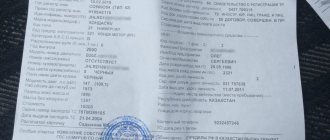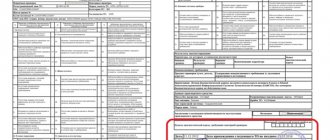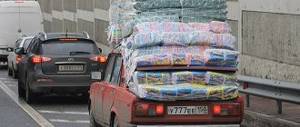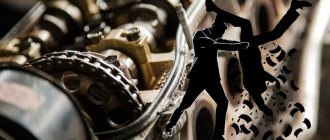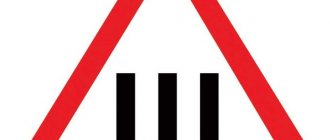The issue of registering changes made to the design of vehicles is very, very relevant. Since sometimes minor changes to a vehicle can change the weight balance, affect the friction force, speed characteristics, range and much more.
Dear readers! Our articles talk about typical ways to resolve legal issues, but each case is unique. If you want to find out how to solve your particular problem, please use the online consultant form on the right or call. It's fast and free!
At the same time, transformations made to the design of the car require appropriate research to determine possible re-equipment and changes to the design features of the car.
In case of permission to carry them out, the law establishes the mandatory reflection of the ongoing transformations in the documents for the car.
What is tuning by law
The state considers tuning any deviation from the factory configuration of the car. The requirements of the Customs Union say which changes can be made to the design of the machine and which cannot. Here are some options:
- installation of bumpers, thresholds, spoilers without a certificate from the car manufacturer;
- exhaust system refurbishment;
- increasing or decreasing ground clearance;
- installation of additional lighting devices;
- installation of special equipment, for example, a tow bar;
- installation and dismantling of gas cylinders;
- replacement of external lighting devices, including installation of xenon or diode lamps;
- re-equipment of a car for disabled people.
The requirements of the Customs Union are necessary so that a tuned car does not create a danger on the road. If the owner attaches a new part to a car in the garage and does not pass the test in a technical laboratory, an accident may occur and people will suffer.
In June 2021, the Customs Union clarified the requirements to clarify the situation for traffic police inspectors and drivers. There are regulations for coordinating improvements with the traffic police. Fines for tuning have become justified and inspectors have no right to arbitrarily fine drivers.
The owner of the car registers such garage modifications as changes to the design of the car.
In what cases should design changes be registered with the traffic police?
Obviously, if you introduce them, you replace components, spare parts, parts or units of the car with others that were not originally installed on your car of your specific modification and configuration, or perform tuning.
In particular, the required registration includes the following improvements to the machine:
- HBO installation,
- replacing the engine with a different model or characteristics,
- installation of additional equipment (winch, turbocharging and others),
- equipping the car with a tow bar or roof rack, if they have not been tested and do not have a certificate of conformity as part of your vehicle,
- all other changes to the design of the car that are connected to the electrical system and affect road safety (and this may not be so obvious).
A special article about the procedure for installing gas equipment on a car and the procedure for replacing the engine with a similar or non-similar one.
When is it not necessary to register?
The new rules refer to the Technical Regulations on the Safety of Wheeled Vehicles in that there is no need to check the compliance of the changes made.
Clause 77 of the regulations states 2 cases when registration with the traffic police of such improvements is not necessary:
- if the operating documentation for your machine specifies these components by the manufacturer,
- if parts or assemblies are intended for your car: they have been tested as part of your model and modification and have an appropriate certificate of conformity.
What kind of tuning will cause your car's registration to be revoked?
The car will be deregistered if the driver does not eliminate the changes in the design or does not register them. This applies to appearance, power and the type of fuel the car runs on. This is stated in clause 6, part 1, art. 18 of the Law on Vehicle Registration.
For example, according to the title the car is a blue Lada Vesta with a 1.6 liter engine, but in fact it is a red Vesta pickup with a five liter engine from BMW. Or the owner installs a huge speaker and a gas cylinder, which block the view of the rear window.
They will not remove the license plates on site, but they will deregister the car. Here's how it works in practice:
Alexander Torvard, auto lawyer at Dorogahelp
If an inspector stops a car and explains the reason for the stop by saying that the car has non-standard structures such as a winch or a lowered suspension, he will most likely issue a fine. In addition, he will write an order to eliminate or register new mechanisms. Information about the order will be included in the traffic police database. If the driver does not change anything within 10 days, the registration will be canceled and they will be required to hand over the STS and license plates.
What has changed in 2021
- On February 1, 2021, Order of the Ministry of Economic Development No. 477 dated July 31, 2020 came into force, which puts into force a new, unified register of conclusions and protocols from testing laboratories. If previously each laboratory had its own register, now it is unified and state-owned. The absence of a laboratory document in this register is a reason for the traffic police inspector to refuse to re-equip it. Due to the transition to a single registry, all laboratories faced enormous difficulties with access to the registry, unstable operation of the service and additional costs for downloading each client document. Which increased the period for issuing an expert document from 1 working day to 10 (and sometimes more).
- Transition to an electronic digital signature (EDS). The familiar laboratory forms are leaving the market and now the client receives the document not on paper, but on a digital one, i.e. in electronic form and certified by the digital signature of the laboratory director. In the future, this should translate re-equipment services into the format of electronic government services.
- Increased cost of examination due to greater responsibility of the laboratory and additional requirements for issued documents. For the client, the procedure becomes simpler, but for the laboratory it is more difficult and longer, which leads to an increase in the preparation time for documents and the cost of issuing them. For issuing a document that contains violations of the current requirements of TR CU 018 and other GOSTs, the laboratory will receive a fine of 400,000 rubles and its current accreditation will be suspended, so a more thorough check of each client document and compliance of the vehicle with the planned changes is required.
There are other changes planned, but these are the most important ones for now. These changes practically do not affect the sequences and stages of the procedure and we will talk about it further, but for now we will focus on the regulatory framework that regulates changes to the design of the vehicle.
Commentary by the leading auto lawyer of the NEXT Refurbishment Center A. Ozherelev.
How to register changes to a car's design
Select a laboratory. You cannot register changes to your car at any car service center; by law, they are checked by a certified technical laboratory or testing center. There are these in every region. How to choose a laboratory, read below.
Agree on the planned changes. Send an email to the accredited center about what changes you want to make. Get a positive conclusion. Submit this document along with your application to the traffic police technical supervision department.
Refurbish a car. The owner of the car has the right to make changes independently or at a car repair shop.
Pass a technical inspection and receive a diagnostic card. This can be done at any point where they do a technical inspection and issue a state-issued certificate for the traffic police.
Be tested at an accredited center and receive a protocol. Laboratory workers will compare what the owner planned to do with what was done.
Take the documents to the traffic police. You will need documents: PTS, STS, protocol, copies of certificates of conformity for used spare parts certified by a notary and a receipt for payment of the state duty - 800 rubles.
Submit the car for examination to traffic police officers. Technical supervision employees will check the documents with the car that the owner brought. If everything matches, a vehicle design safety certificate (SVTS) will be issued.
Take all documents to the registration department of the traffic police. This is the final stage - the owner will be given a new PTS and STS.
In what cases is registration required?
Changes do not apply to all elements and mechanisms of the vehicle. At the same time, modification and improvement of the car are not prohibited if this does not affect the safety of movement or violation of traffic rules. The main reasons for contacting the traffic police to make changes are:
- replacing a faulty engine;
- installation of equipment that affects the characteristics of the machine;
- car repainting, etc.
These are the most common reasons for entering new data. However, the list is not limited to these items. Re-registration is required if the following parameters and design elements of the vehicle are changed:
- weight and dimensions of equipment;
- power unit;
- chassis, gearbox (transmission), controls;
- brake system;
- optical external lighting devices (headlights, taillights, fog lights);
- car body;
- fuel supply systems;
- boarding seats.
Due to rising fuel prices, many today install gas equipment on vehicles. It also requires re-registration of documents.
How to check the center's accreditation
Why check? If an unscrupulous center comes across, it will take the money and issue a fake document. Not all centers have the right to issue documents for the conversion of any machine. One laboratory tests only buses and issues a report on changes in the design of the buses. Another has accreditation only for checking gas equipment on passenger cars, which means that she will draw up a protocol only about this. If the traffic police do not check the accreditation, the fake may be discovered on the road.
Where to view accreditation. Open the website of the Federal Accreditation Service and fill in the filters on the right. Select:
- Status: Active
- Type of accredited entity: Testing laboratories,
- Technical regulations of the EAEU: TR CU 018/2011.
The Federal Accreditation website sometimes works with a delay, the buttons do not respond immediately
Click “Find” - a list of centers and laboratories will appear on the right. At the time of publication of this article, there are 57 of them. See the last column “Description of the scope of accreditation.” It indicates what types of vehicles the laboratory is authorized to examine.
If the laboratory you were planning to contact is not on this list, it is better to choose another one. Otherwise, the traffic police inspector may consider changes in the design of the car illegal and prohibit you from driving it.
- Tuning - any differences from the factory equipment of the car.
- The fine for illegal tuning is up to 500 rubles. For repeated violation - up to 5,000 rubles.
- In addition to the fine, the inspector will cancel the registration of the car - you will no longer be able to drive it.
- To register changes, you will have to find an accredited laboratory in the city and go to the traffic police several times.
- After all the procedures, you will receive a PTS and STS with new data.
All articles by the author: Evgeniy Lesnov
How to register design changes
Registration of technical changes to the design of a car is a complex and lengthy process.
A car enthusiast who decides to seriously improve his car will have to undergo a couple of examinations - one to obtain permission, and the second after modification.
You need to undergo maintenance, then pay the state fee, collect and submit a package of documents and a corresponding application to the State Traffic Inspectorate.
What documents will be required?
One of the most difficult obstacles on the way to the cherished goal is quite rightly considered to be the correct execution of documents for the conversion of vehicles. In addition to the application, you must submit to the traffic police:
- passport;
- PTS, if it is not electronic;
- OSAGO policy;
- preliminary expert opinion;
- technical examination protocol;
- certificates for additional equipment;
- duty payment receipt.
How is the examination carried out?
Essentially, the examination of a converted car is divided into two parts:
- Based on the preliminary results, a conclusion is drawn up, which is required for permission from the traffic police.
- Checking the safety of the design with the issuance of a technical examination report after making changes necessary for registration.
The procedure can be performed by any accredited expert institution. This is far from a simple inspection, but a serious analysis:
- is it possible to make changes to the design of the machine;
- assessment of the safety of vehicle operation after modification.
Procedure for registering design changes
The algorithm for registering refurbishment includes several stages:
- Passing a preliminary examination. The list of accredited organizations is available on the official website of the EEC.
- Contacting the traffic police with an application for re-equipment.
- Passing maintenance after modification of the car.
- Repeated technical examination (in the organization that issued the preliminary conclusion).
- Submission of documents to the State Traffic Inspectorate.
- Vehicle inspection.
- Making changes to the PTS and issuing a new STS (COP).
HBO registration
The center that installed the gas equipment must issue the vehicle owner an acceptance certificate, a quality certificate and a declaration on the scope of work performed. These papers must be attached to the package of documents indicated above when applying to the State Traffic Inspectorate for the purpose of registration.
The owner of the car will receive SKTS, a new SOP (STS) and PTS with the changes made (if it is not electronic). Registration takes place in one day.
Find out in more detail about registering HBO on a car.
Color change and airbrushing
Repainting a car is not uncommon. Many car enthusiasts are interested in airbrushing, stickers, and so on. Both require registration.
The color does not affect the safety and performance of the car. However, it is indicated in the registration documents and the fundamental discrepancy will have to be eliminated in the manner described above. If we are talking about changing only the tone, you just need to notify the traffic police within five days (a reconciliation will be made).
Find out how to register a change in car color with the traffic police.
Do I need to register the towbar?
As a rule, we rarely buy a factory towbar due to the high cost or complexity of ordering and delivery. But homemade ones can differ greatly in weight, method of fastening, strength, and so on. In addition, it is attached to the load-bearing elements of the structure, so registration of the towbar, if it is installed on a vehicle, is required.
Registration of design changes to cars discontinued from production
It is possible to make changes to the design of a published car model in the same way as any other. VAZ, for example, considers it acceptable to use standardized components, assemblies and parts of newer models when repairing cars for which spare parts are no longer produced (over 10 years old).
In addition, the installation of bodies and engines does not depend on the year of manufacture, but on their actual technical condition. You can read about this in the letter of the chief designer of VAZ No. 30000-49/3878 dated October 18, 2002.
When the traffic police may refuse to register changes
Motorists are interested in the question of why the traffic police refuses permission and registration of changes to the design of the vehicle. It's very simple - traffic safety is a top priority. Order of the Ministry of Internal Affairs No. 605 (as amended on September 6, 2017) lists the reasons for refusing registration:
- the information in the provided documents is unreliable or does not comply with the law;
- The vehicle is manufactured from component parts or imported without documents confirming certification or with restrictions from customs authorities;
- the design does not meet safety requirements, or the changes presented in the documents do not correspond to the real ones;
- there are visible signs of falsification of identification numbers, discrepancies between the information in the provided documents and the actual numbers (except in cases of natural wear, corrosion, repair or after theft, subject to identification).
You cannot register a car without original documents and if it is on the wanted list. The Law “On State Registration of Vehicles...” No. 283-FZ also clearly states that the inability to identify a car after replacing the frame or body is considered grounds for refusal of registration. The owner is allowed to fix the problems. If identification numbers are damaged, additional markings will need to be applied.
Rules for the conversion of vehicles: what laws govern them?
1. Decree of the Government of the Russian Federation dated 04/06/2019 N 413 (as amended on 02/01/2021) The resolution sets out the procedure for making changes to the design of vehicles and the necessary documents for registering the conversion with the State Traffic Inspectorate. As well as requirements for the content of documents: the conclusion of a preliminary technical examination and a protocol for checking the safety of the vehicle design after changes made to it.
IMPORTANT! From February 1, 2021, without a conclusion or protocol from the testing center in the unified FSA register, all changes will be considered illegal.
2. Technical Regulations of the Customs Union - TR CU 018/2011 “On the Safety of Wheeled Vehicles” The Technical Regulations contain the rules for the circulation on the market or commissioning of wheeled vehicle objects and requirements for their safety.
The document specifies the size and weight restrictions applicable to vehicles, requirements for the types of vehicles (chassis) put into circulation, requirements for individual changes made to the design of the vehicle, etc. 3. Code of Administrative Offenses of the Russian Federation Article 12.5 Prescribed fines for driving a car in the presence of malfunctions or conditions under which the operation of vehicles is prohibited, for example: with illegal changes in the design or a vehicle on which the identification sign “Disabled” is illegally installed.
Which documents to refer to?
Document title and link
“On approval of the Rules for making changes to the design of wheeled vehicles in operation and subsequent verification of compliance with the requirements of the technical regulations of the Customs Union “On the safety of wheeled vehicles”
Establishes a general procedure for making changes to the design
Driving a vehicle in the presence of malfunctions or conditions under which the operation of vehicles is prohibited, or a vehicle on which the identification sign “Disabled” is illegally installed
Fines have been prescribed for driving a car with illegal modifications to its design.
“On approval of the Administrative Regulations of the Ministry of Internal Affairs of the Russian Federation for the provision of public services for issuing permission to make changes to the design of a wheeled vehicle in operation”
It is spelled out how the state service for issuing permission to make changes to the design of a wheeled vehicle in operation is provided
“On approval of the Administrative Regulations of the Ministry of Internal Affairs of the Russian Federation for the provision of public services for issuing a certificate of compliance of a vehicle with changes made to its design with safety requirements”
The procedure for issuing a certificate of compliance of a vehicle with changes made to its design with safety requirements is prescribed
“On the adoption of the technical regulations of the Customs Union “On the safety of wheeled vehicles”
The document states which changes to the design cannot be made and which can be made.
Checking fines for legal entities
Do you want to monitor fines, receive a daily report on new fines found and pay them?
